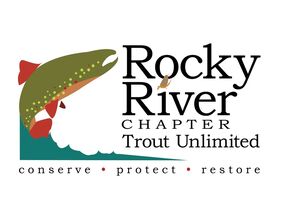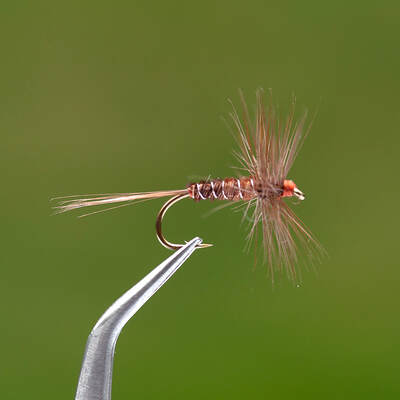Tying the fly pattern for the Bronze Level Submission
Visit the FFI website and navigate to the Fly Tying Group, then to the Bronze Award Handbook pages. The website has excellent instructions as to how to tie and submit the required group of fly patterns to an FFI Bronze Award Evaluator. The website includes a video presenting each step to tie the Dry Pheasant Tail Variant. The handbook is easy to understand and follow. Tie three flies with consi Fly of the Month 02.23 Dry Pheasant Tail Variant
The “fly of the month” series for 2023 will celebrate the Fly Fishers International Fly Tying Group Fly Tying Skills Awards Program. Each month Tom and I will present one of the fly patterns used to evaluate a fly tyer’s skills toward a Bronze Level in the first six months, then one of the fly pattern used to evaluate a fly tyer’s skills toward a Silver Level in the later part of the year. The second fly pattern in the Bronze Level series is a variant. A variant is a modification of a similar fly pattern and in this case, rather than wings, the fly pattern utilizes a longer, bushier hackle as the spent wings and for an improved float.
Dry Pheasant Tail Variant
The Pheasant Tail fly pattern is a generic imitation of a mayfly and the Dry Pheasant Tail Variant is intended to imitate a blue-winged olive spinner. Created by Frank Sawyer to fish the chalk streams in the south of England, it is used on other rivers and streams across the world and is a killer. Sawyer’s original nymph fly pattern was tied using only two materials: copper wire and fibers from the tail feather of a pheasant. The copper was used as weight and, substituted for thread, was what tied the pheasant fibers to the hook.
The Pheasant tail fly pattern has evolved to be many different flies including a more complex nymph, a wet fly, a dry fly and a variant or spinner in this case. The American Pheasant Tail Nymph uses pheasant tail fibers for legs, turkey for the Wingcase and peacock herl for the thorax. The Pheasant Tail Dry uses hackle tips for wings. The Pheasant Tail Wet uses duck quill for the wing.
Other often used variants tied in the Catskill style include the Badger Variant, Cream Variant and Dun Variant. Each of these fly patterns imitate the spinner stage of various mayflies and provide improved float.stency for the Bronze Awards submission, then tie more for the fly box.
Fly of the Month 02.23
Dry Pheasant Tail Variant
Hook: #12 Dry fly hook
Thread: 8/0 Rust Uni-thread or equivalent
Tail: Badger rooster hackle fibers (brown or variant hackle may be substituted )
Rib: Fine silver wire
Body: Pheasant rooster tail fibers
Hackle: Badger rooster hackle fibers (brown or variant hackle may be substituted)
Head: Whip-finish and head cement
Directions:
1) Insert the hook into the vise. Attach the thread about 1 eye length behind the hook eye.
2) Wrap a thread base to form an underbody with adjacent turns. Wrap the thread base back to a the bend of the hook.
3) Tie in 10 to 15 hackle fibers for a tail. Use enough fibers to support the fly. Bend down the waste along the hook shank.
4) Attach the silver wire rib and bind the wire down onto the shank of the hook. Wrap the thread back to the base of the tail. For strength, you may want to form a small “U” shape on the wire after attaching it with 3 or 4 turns and blind down the wire waste as you wrap back over the wire. This allows you to pull on the wire without fear of it pulling loose when you wrap it forward.
5) Attach 4 strands of pheasant tail fibers by the tips and bind the strands down as you take the thread to the rear. Wrap the thread forward to the point 1 eye length behind the eye of the hook.
6) Wrap the pheasant tail fibers up the body with minimum twisting to form the body.
7) Counter wrap the silver wire rib forward and tie off at the end of the body. Instead of cutting the wire, wiggle it back and forth using the “helicopter” technique to remove the metal waste. make sure you stop short enough of the eye to allow for space for the head hackle.
8) Tie in the badger hackle. If you use 1 hackle, be sure the fibers angle forward as you wrap the hackle forward. You may want to use 2 hackles attached belly to belly. This gives you fibers slanting both forward and backwards as you wrap them forward. Trim the feather stem waste.
9) Wrap several turns of hackle forward. Each turn should touch but not overlapping the previous one as you wrap toward the eye. The number of turns will depend on the quality of the hackle. Tie off the hackle. Carefully trim off the waste hackle.
10) Form a neat head, whip-finish and apply head cement.
- Tom Adams, Alen Baker
Visit the FFI website and navigate to the Fly Tying Group, then to the Bronze Award Handbook pages. The website has excellent instructions as to how to tie and submit the required group of fly patterns to an FFI Bronze Award Evaluator. The website includes a video presenting each step to tie the Dry Pheasant Tail Variant. The handbook is easy to understand and follow. Tie three flies with consi Fly of the Month 02.23 Dry Pheasant Tail Variant
The “fly of the month” series for 2023 will celebrate the Fly Fishers International Fly Tying Group Fly Tying Skills Awards Program. Each month Tom and I will present one of the fly patterns used to evaluate a fly tyer’s skills toward a Bronze Level in the first six months, then one of the fly pattern used to evaluate a fly tyer’s skills toward a Silver Level in the later part of the year. The second fly pattern in the Bronze Level series is a variant. A variant is a modification of a similar fly pattern and in this case, rather than wings, the fly pattern utilizes a longer, bushier hackle as the spent wings and for an improved float.
Dry Pheasant Tail Variant
The Pheasant Tail fly pattern is a generic imitation of a mayfly and the Dry Pheasant Tail Variant is intended to imitate a blue-winged olive spinner. Created by Frank Sawyer to fish the chalk streams in the south of England, it is used on other rivers and streams across the world and is a killer. Sawyer’s original nymph fly pattern was tied using only two materials: copper wire and fibers from the tail feather of a pheasant. The copper was used as weight and, substituted for thread, was what tied the pheasant fibers to the hook.
The Pheasant tail fly pattern has evolved to be many different flies including a more complex nymph, a wet fly, a dry fly and a variant or spinner in this case. The American Pheasant Tail Nymph uses pheasant tail fibers for legs, turkey for the Wingcase and peacock herl for the thorax. The Pheasant Tail Dry uses hackle tips for wings. The Pheasant Tail Wet uses duck quill for the wing.
Other often used variants tied in the Catskill style include the Badger Variant, Cream Variant and Dun Variant. Each of these fly patterns imitate the spinner stage of various mayflies and provide improved float.stency for the Bronze Awards submission, then tie more for the fly box.
Fly of the Month 02.23
Dry Pheasant Tail Variant
Hook: #12 Dry fly hook
Thread: 8/0 Rust Uni-thread or equivalent
Tail: Badger rooster hackle fibers (brown or variant hackle may be substituted )
Rib: Fine silver wire
Body: Pheasant rooster tail fibers
Hackle: Badger rooster hackle fibers (brown or variant hackle may be substituted)
Head: Whip-finish and head cement
Directions:
1) Insert the hook into the vise. Attach the thread about 1 eye length behind the hook eye.
2) Wrap a thread base to form an underbody with adjacent turns. Wrap the thread base back to a the bend of the hook.
3) Tie in 10 to 15 hackle fibers for a tail. Use enough fibers to support the fly. Bend down the waste along the hook shank.
4) Attach the silver wire rib and bind the wire down onto the shank of the hook. Wrap the thread back to the base of the tail. For strength, you may want to form a small “U” shape on the wire after attaching it with 3 or 4 turns and blind down the wire waste as you wrap back over the wire. This allows you to pull on the wire without fear of it pulling loose when you wrap it forward.
5) Attach 4 strands of pheasant tail fibers by the tips and bind the strands down as you take the thread to the rear. Wrap the thread forward to the point 1 eye length behind the eye of the hook.
6) Wrap the pheasant tail fibers up the body with minimum twisting to form the body.
7) Counter wrap the silver wire rib forward and tie off at the end of the body. Instead of cutting the wire, wiggle it back and forth using the “helicopter” technique to remove the metal waste. make sure you stop short enough of the eye to allow for space for the head hackle.
8) Tie in the badger hackle. If you use 1 hackle, be sure the fibers angle forward as you wrap the hackle forward. You may want to use 2 hackles attached belly to belly. This gives you fibers slanting both forward and backwards as you wrap them forward. Trim the feather stem waste.
9) Wrap several turns of hackle forward. Each turn should touch but not overlapping the previous one as you wrap toward the eye. The number of turns will depend on the quality of the hackle. Tie off the hackle. Carefully trim off the waste hackle.
10) Form a neat head, whip-finish and apply head cement.
- Tom Adams, Alen Baker

